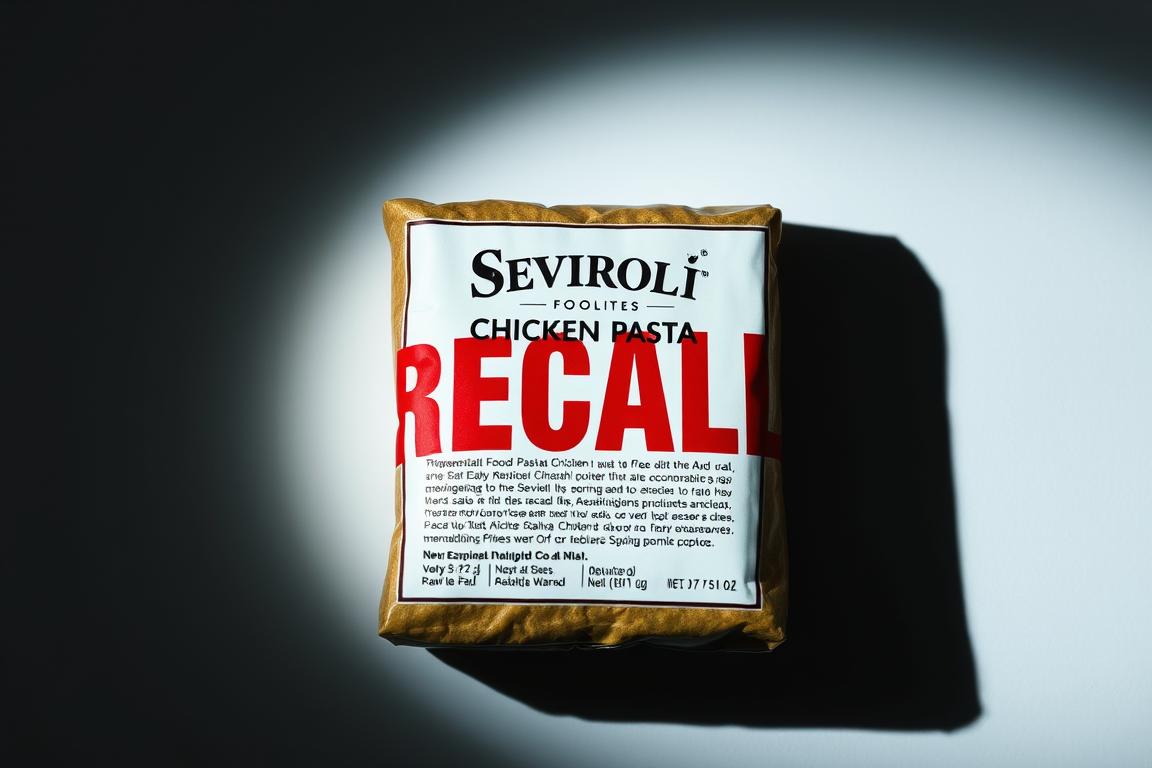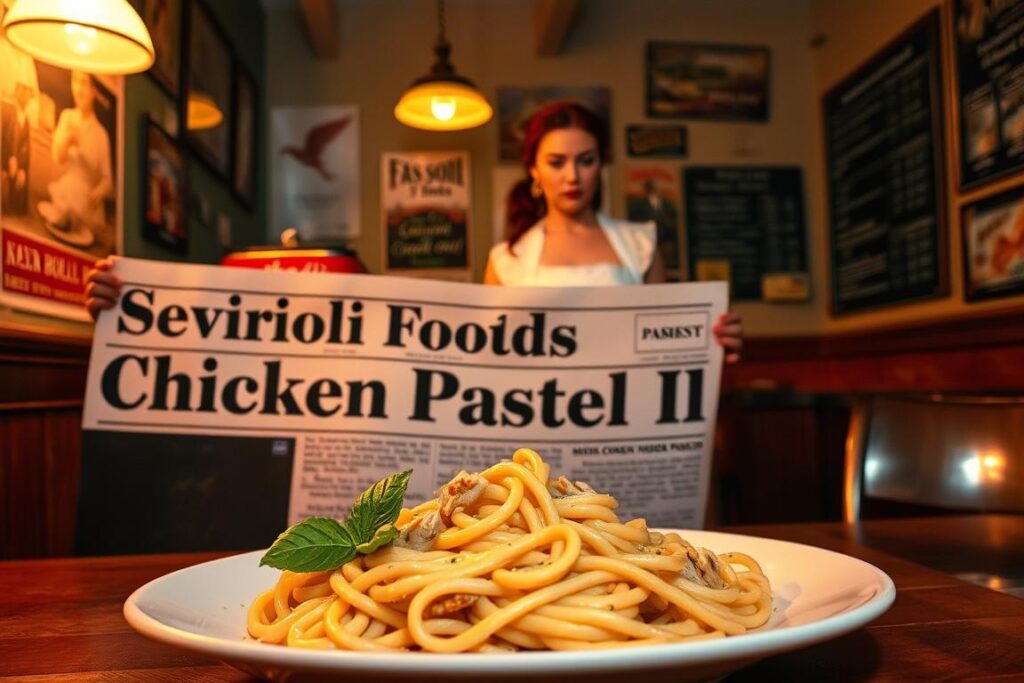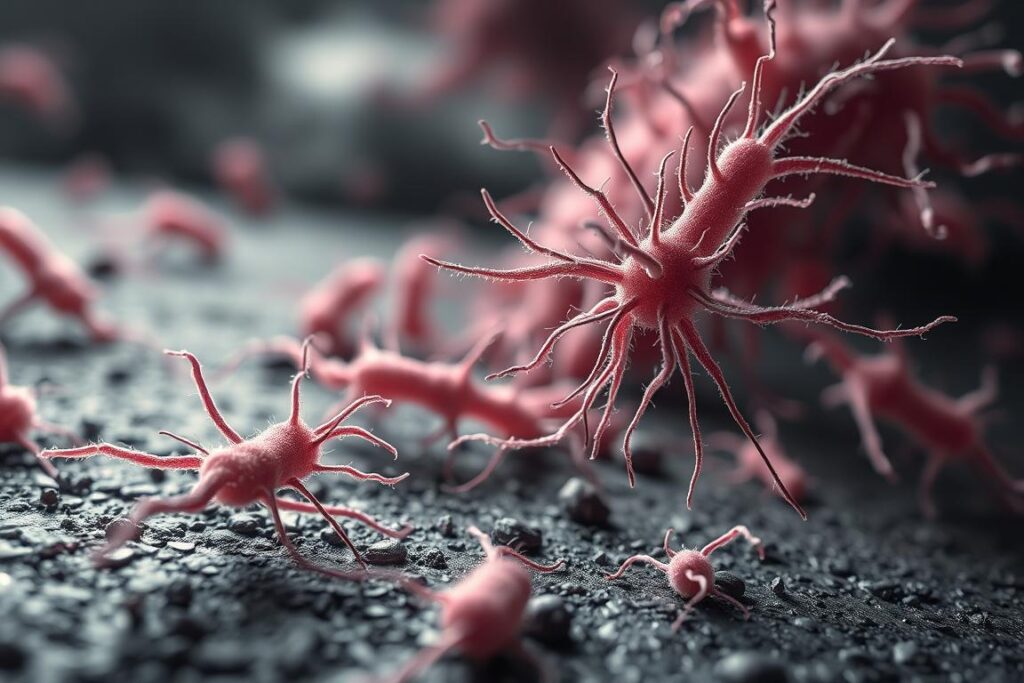
Is your kitchen hiding a danger? The Seviroli Foods chicken pasta recall has shocked 15 states. It shows families need to watch out for food safety risks right now. Imagine finding out a meal in your freezer could be harmful.
Joseph Seviroli, LLC has recalled over 1.3 million pounds of Chicken Alfredo Kits. This is a big move to protect many homes from Listeria. The recall was announced on October 9, and it’s a call to action for everyone.
This recall is more than just a notice. It’s a wake-up call for families across the U.S. to check their food at home.
Key Takeaways
- Over 1.3 million pounds of Chicken Alfredo Kits recalled
- Recall spans 15 states nationwide
- Potential Listeria contamination identified
- Product code 16769427 is specially affected
- No illnesses reported as of the recall date
Understanding the Seviroli Foods Chicken Pasta Recall
The recent recall of Seviroli Foods chicken pasta has caused a big stir in the ready-to-eat meals market. It has raised serious food safety concerns for people all over the United States. A large amount of chicken pasta products were distributed to many states.
Recall Magnitude and Scope
The recall covers a huge 1.36 million pounds of chicken pasta. It’s because of a risk of Listeria contamination. Seviroli Foods quickly acted to keep consumers safe by recalling all products nationwide.
Geographic Distribution
The products were sent to 15 key states. These include:
- New York
- Georgia
- Indiana
- Pennsylvania
- Texas
- California
- Florida
- Illinois
- Missouri
- Ohio
- North Carolina
Identifying Recalled Products
To stay safe, check your chicken pasta for these details:
- Brand: Joseph Seviroli, LLC
- Product: Chicken Alfredo Kit
- Size: 1366065
- Code Information: 16769427

“Consumer safety is our top priority,” stated Seviroli Foods representatives regarding the product recall.
The FDA has labeled this a Class I risk. This means there’s a serious health risk from eating these products. People are urged to check their fridges and throw away or return any matching items.
Listeria Contamination: The Root Cause
Listeria monocytogenes is a big threat in foodborne illness, mainly for those who are more at risk. This harmful bacterium can live in cold places, making it hard to stop its spread with just refrigeration. Eating food that’s contaminated can lead to serious health issues.

- Can survive refrigeration temperatures
- Extended incubation period up to 70 days
- High risk for pregnant women, elderly, and immunocompromised individuals
“Understanding Listeria’s transmission is key to avoiding serious food regulation violations,” says food safety expert Dr. Elena Rodriguez.
Symptoms of salmonella contamination and Listeria infection can be very bad. They include:
- Persistent fever
- Muscle aches
- Severe headache
- Neck stiffness
- Potential neurological complications
| Risk Group | Potential Complications |
|---|---|
| Pregnant Women | Premature delivery, stilbirth |
| Elderly | Severe systemic infection |
| Immunocompromised | Life-threatening infections |
Food safety needs careful watching and strict cleaning to stop dangerous bacterial contamination.
BrucePac Connection and Supply Chain Impact
Food safety issues in the poultry industry show how complex it is. The Seviroli Foods recall points out big problems in supply chains.
The recall started with BrucePac, a big poultry supplier. They faced huge contamination risks. Their recall affected over 10 million pounds of meat. This meat was sold at big stores like:
- Trader Joe’s
- Walmart
- Aldi
Initial Recall Details
Seviroli Foods found out BrucePac made the contaminated chicken. This led to a big recall. The inspection showed serious food safety issues.
| Manufacturer | Product Affected | Distribution Scale |
|---|---|---|
| BrucePac | Raw Chicken | 10+ Million Pounds |
| Seviroli Foods | Chicken Pasta Kits | Multiple Retail Chains |
Manufacturer Relationship
The link between Seviroli and BrucePac shows how fast contamination can spread. Seviroli is now getting chicken from other suppliers to avoid risks.
“We are taking immediate steps to ensure consumer safety and prevent future contamination incidents.” – Seviroli Foods Representative
Supply Chain Response
Stores like Trader Joe’s, Walmart, and Aldi acted fast. They pulled the bad products off their shelves. This shows how important food safety is for keeping people healthy.
FDA Risk Classification and Safety Measures
The Food and Drug Administration (FDA) has issued a Class I recall for Seviroli Foods chicken pasta. This is the most serious food safety classification. It shows a high risk to consumer safety.
Class I recalls are for products that could cause serious health problems. The FDA calls for these recalls when a product is a big threat to public health.
- Highest risk level for food safety violations
- Potential for serious adverse health consequences
- Immediate action required by manufacturers and distributors
The FDA has taken several steps to ensure safety:
- Removing products from store shelves right away
- Tracking where the products were sent
- Telling consumers about the recall
“Our primary concern is protecting public health through swift and decisive action.” – FDA Representative
| Recall Classification | Risk Level | Consumer Action |
|---|---|---|
| Class I | Highest Risk | Discard or Return Product |
| Class II | Moderate Risk | Monitor for Symptoms |
| Class III | Low Risk | Product Replacement |
Check your pantry and fridge for the chicken pasta. Your safety depends on quick action and knowing these food safety rules.
Identifying Affected Products and Code Numbers
During the Seviroli Foods chicken pasta recall, it’s key to know which products are affected. The recall includes several chicken pasta items with specific batch codes. These codes need to be checked carefully.
For your safety, make sure to check your chicken pasta for important details. This includes:
Product Specifications
- Manufacturer: Joseph Seviroli, LLC
- Product Type: Chicken Alfredo Kits
- Recall Initiation Date: October 9, 2023
- Distribution: 15 states across the United States
Batch Codes to Watch For
The recall includes specific product codes that you need to look for. Here are the key batch codes:
| Product Code | Details |
|---|---|
| 54238 | First recalled batch |
| 54239 | Second recalled batch |
| 54247 | Third recalled batch |
| 54248 | Fourth recalled batch |
To see if your product is recalled, look for the product code on the packaging. If it matches any of these codes, do not eat it. Contact Seviroli Foods or return it to where you bought it for a refund.
“Your safety is our top priority. Always check product codes during a food safety recall.”
Quickly identifying and acting on the recall can help avoid health risks.
Health Risks Associated with Listeria Exposure
It’s important to know the dangers of Listeria contamination to keep you safe. Listeria is a serious illness that can harm certain groups of people.
The effects of Listeria can vary based on your health. Key risk factors include:
- Age and immune system strength
- Overall health status
- Duration of exposure
Symptoms of Listeria infection come in two stages:
| Intestinal Illness | Invasive Listeriosis |
|---|---|
| Onset: Within 24 hours | Onset: Within two weeks |
| Duration: 1-3 days | Can persist for weeks |
| Symptoms: Fever, headaches | Symptoms: Confusion, balance loss |
“Listeria can be very dangerous for pregnant women, the elderly, and those with weak immune systems.” – Public Health Expert
Here are some important health statistics:
- About 1,600 people get infected each year.
- Almost 260 deaths happen yearly from listeriosis.
- Nonpregnant people face a death rate of about 1 in 6 with invasive listeriosis.
Seek medical help right away if you have ongoing symptoms after eating possibly contaminated food.
Timeline of Contamination Discovery and Response
The Seviroli Foods chicken pasta recall showed how important food safety is. It involved many steps to keep food safe for everyone. Knowing the timeline helps us understand how these steps work together.
For more information on recent food recalls, visit our Food Safety Alerts page.
Initial Detection and Notification
The recall started on October 9. The USDA warned about possible Listeria monocytogenes in BrucePac’s products. This alert led to a deep look into the supply chain.
Key Chronological Actions
- October 9: USDA initial contamination alert issued
- October 10-11: Seviroli Foods begins internal investigation
- October 12: Decision made to initiate voluntary recall
- October 13: Formal recall procedure implemented
Regulatory Involvement
Many government agencies worked together during the recall. The FDA and USDA helped find the contamination source. They also checked health risks and helped the manufacturer respond.
“Rapid response and transparent communication are critical in managing food safety incidents.” – Food Safety Expert
| Date | Action | Responsible Agency |
|---|---|---|
| October 9 | Initial Contamination Alert | USDA |
| October 12 | Recall Decision | Seviroli Foods |
| October 13-15 | Product Tracing | FDA |
The quick and united effort shows how strong food safety systems are. They protect us from contamination risks.
Consumer Safety Guidelines and Recommendations
When a food safety advisory is issued, acting fast can keep you and your family safe. The Seviroli Foods chicken pasta recall is a big deal. It’s important to take steps to avoid any health issues.
- Verify your product’s item code 16769427
- Check packaging for specific batch details
- Immediately remove affected items from your kitchen
- Prevent cross-contamination by securely disposing of products
“Safety begins with awareness and swift action in food recalls” – Food Safety Experts
The recall affects 15 states, including New York, California, and Texas. People with weak immune systems, pregnant women, kids, and seniors need to be extra careful.
| Risk Group | Recommended Actions |
|---|---|
| Pregnant Women | Monitor for symptoms, consult healthcare provider |
| Immunocompromised | Avoid consuming potentially contaminated products |
| Children/Elderly | Perform thorough kitchen sanitation |
Symptoms of listeriosis can take up to 70 days to show. If you have concerns, contact Joseph Seviroli, LLC for refunds or more info.
Impact on Retailers and Distribution Networks
The Seviroli Foods chicken pasta recall has caused big problems for national retail and distribution networks. Big names like Trader Joe’s, Walmart, and Aldi are dealing with a big food safety issue. They need to act fast and accurately.
Retailers had to take quick steps to handle the recall. They had to find and take out the bad products fast to keep people safe.
Affected Store Locations
The recall hit many states in the U.S. Stores in these areas had to:
- Stop selling certain chicken pasta products
- Take the bad items off the shelves
- Let customers know about the health risks
Removal Procedures
Removing the bad products needed a careful plan:
| Step | Action | Responsibility |
|---|---|---|
| 1 | Identify Specific Products | Manufacturer/Distributor |
| 2 | Notify Retail Partners | Seviroli Foods |
| 3 | Remove Products from Shelves | Retail Staff |
| 4 | Customer Notification | Individual Retailers |
The recall cost a lot. Studies show it can cut sales by 2% to 10%. Also, up to 60% of shoppers might not buy from brands that had recalls.
“Swift and transparent action is key to maintaining consumer confidence during food safety challenges.” – Food Safety Expert
Retailers must keep customers safe while also not losing too much money. This is a tough job in handling big recalls.
Understanding Listeria’s Unique Characteristics
Listeria is a tough foodborne illness that goes beyond usual food safety rules. It’s different because it can survive in ways many bacteria can’t. This makes it a big problem in food production.
What makes Listeria so dangerous includes:
- Ability to survive refrigeration temperatures
- Persistent growth in cold storage conditions
- Resistance to standard food preparation methods
Being aware of food safety is very important, mainly with certain high-risk foods. Chilled ready-to-eat foods, unpasteurized dairy products, precooked meats, and precut fruits and vegetables are at high risk of Listeria contamination.
“Listeria’s resilience makes it a formidable challenge in food production and safety management.” – Food Safety Expert
Because of Listeria’s unique traits, usual ways to stop salmonella contamination don’t work. People who are pregnant, elderly, or have weak immune systems are at the highest risk.
Using proper food handling is your best way to avoid Listeria. Keeping food at the right temperature, cleaning well, and knowing how Listeria survives can help lower the risk of contamination.
Steps for Product Returns and Refunds
If you bought Seviroli Foods chicken pasta that’s been recalled, it’s important to know how to return it. This is for your safety and to protect your rights as a consumer. The recall process has clear steps to help you.
- Locate your specific product package
- Check the product lot code and expiration date
- Prepare the original packaging
- Contact Seviroli Foods customer service
Customers have several ways to ask for refunds:
- Phone Support: Call the dedicated recall hotline
- Online Submission: Visit the official Seviroli Foods website
- In-Store Returns: Bring the product to the original point of purchase
“Consumer safety is our top priority during this recall procedure,” says Seviroli Foods management.
To get a refund, you’ll need to show the original packaging, proof of purchase, and details about the product. The recall process is made easy and friendly for consumers.
Conclusion
The Seviroli Foods chicken pasta recall is a big wake-up call for food safety in the U.S. About 7,000 pounds of products might be affected. This shows how vital it is to have strong public health alerts to keep us safe.
Being aware and taking action is key to avoiding food safety risks. The Class I recall warns of serious health issues from tainted food. By staying alert and informed, you help keep everyone safe and support better food safety rules.
Food safety is a team effort. It involves consumers, makers, distributors, and agencies like the USDA Food Safety and Inspection Service. This recall shows the importance of constant checks, quick actions, and clear talks in the food world.
As a consumer, your role is important. Keep up with recalls, follow advice, and always put your health first. The Seviroli Foods chicken pasta recall is a reminder to stay careful with our food every day.
